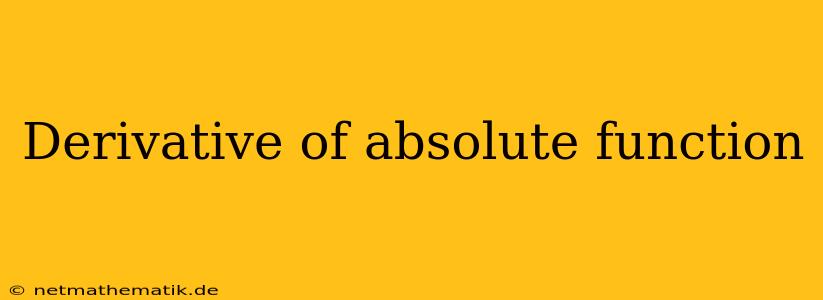The absolute value function, denoted by |x|, plays a crucial role in mathematics and its applications. Understanding its derivative is essential for analyzing its behavior and solving problems involving optimization, calculus of variations, and more. This article delves into the derivative of the absolute function, exploring its definition, properties, and applications.
The Definition of the Absolute Value Function
The absolute value function, denoted by |x|, represents the distance of a number x from zero on the number line. Formally, it is defined as:
|x| =
- x, if x ≥ 0
- -x, if x < 0
This piecewise definition implies that the absolute value function is always non-negative and symmetric about the y-axis.
The Derivative of the Absolute Value Function
The derivative of the absolute value function exists for all x ≠ 0. However, it is not differentiable at x = 0. This is because the function has a sharp corner at the origin, where the slope changes abruptly.
To find the derivative of the absolute value function for x ≠ 0, we can use the definition of the derivative:
f'(x) = lim(h→0) [f(x + h) - f(x)] / h
For x > 0, we have:
f'(x) = lim(h→0) [|(x + h)| - |x|] / h = lim(h→0) [(x + h) - x] / h = 1
For x < 0, we have:
f'(x) = lim(h→0) [|(x + h)| - |x|] / h = lim(h→0) [-(x + h) + x] / h = -1
Therefore, the derivative of the absolute value function is:
f'(x) =
* 1, if x > 0
* -1, if x < 0
This result implies that the derivative of the absolute value function is a constant function with a value of 1 for positive x and -1 for negative x.
The Non-Differentiability at x = 0
As mentioned earlier, the derivative of the absolute value function does not exist at x = 0. This is because the function has a sharp corner at this point, causing the left-hand and right-hand limits of the derivative to be different.
Let's examine the left-hand and right-hand limits of the derivative at x = 0:
lim(h→0-) [|h| - |0|] / h = lim(h→0-) [-h] / h = -1
lim(h→0+) [|h| - |0|] / h = lim(h→0+) [h] / h = 1
Since the left-hand limit (-1) does not equal the right-hand limit (1), the derivative of the absolute value function does not exist at x = 0.
Applications of the Derivative of the Absolute Value Function
The derivative of the absolute value function finds applications in various areas, including:
- Optimization Problems: The absolute value function is often used to model problems involving minimizing or maximizing a quantity subject to constraints. For example, in linear programming, the objective function may involve absolute values, and the derivative can help find the optimal solution.
- Calculus of Variations: The calculus of variations deals with finding functions that minimize or maximize certain functionals. The absolute value function can appear in these functionals, and its derivative can be used to solve the associated Euler-Lagrange equations.
- Signal Processing: In signal processing, the absolute value function is used to represent the magnitude of a signal. The derivative can help analyze the rate of change of the signal's magnitude and identify important features.
Conclusion
The derivative of the absolute value function is a powerful tool for analyzing the behavior of this important function. Its piecewise definition and non-differentiability at x = 0 are crucial aspects to understand. Its applications in optimization, calculus of variations, and signal processing highlight its importance in diverse fields. Understanding the derivative of the absolute value function is essential for anyone working with this function in mathematical and real-world applications.
